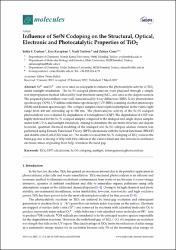| dc.contributor.author | Gürkan, Yelda Yalçın | |
| dc.contributor.author | Kasapbasi, Esra | |
| dc.contributor.author | Türkten, Nazlı | |
| dc.contributor.author | Çınar, Zekiye | |
| dc.date.accessioned | 2022-05-11T14:30:57Z | |
| dc.date.available | 2022-05-11T14:30:57Z | |
| dc.date.issued | 2017 | |
| dc.identifier.issn | 1420-3049 | |
| dc.identifier.uri | https://doi.org/10.3390/molecules22030414 | |
| dc.identifier.uri | https://hdl.handle.net/20.500.11776/7246 | |
| dc.description.abstract | Se4+ and N3- ions were used as codopants to enhance the photocatalytic activity of TiO2 under sunlight irradiation. The Se/N codoped photocatalysts were prepared through a simple wet-impregnation method followed by heat treatment using SeCl4 and urea as the dopant sources. The prepared photocatalysts were well characterized by X-ray diffraction (XRD), X-ray photoelectron spectroscopy (XPS), UV-diffuse reflectance spectroscopy (UV-DRS), scanning electron microscopy (SEM) and Raman spectroscopy. The codoped samples showed photoabsorption in the visible light range from 430 nm extending up to 580 nm. The photocatalytic activity of the Se/N codoped photocatalysts was evaluated by degradation of 4-nitrophenol (4-NP). The degradation of 4-NP was highly increased for the Se/N codoped samples compared to the undoped and single doped samples under both UV-A and sunlight irradiation. Aiming to determine the electronic structure and dopant locations, quantum chemical modeling of the undoped and Se/N codoped anatase clusters was performed using Density Functional Theory (DFT) calculations with the hybrid functional (B3LYP) and double-zeta (LanL2DZ) basis set. The results revealed that Se/N codoping of TiO2 reduces the band gap due to mixing of N2p with O2p orbitals in the valence band and also introduces additional electronic states originating from Se3p orbitals in the band gap. | en_US |
| dc.description.sponsorship | Yildiz Technical University Research FoundationYildiz Technical University [29-01-02-KAP01]; National Center for High Performance Computing of Turkey (UYBHM) [1001162011] | en_US |
| dc.description.sponsorship | The authors express their thanks to Yildiz Technical University Research Foundation for financial support (Project No. 29-01-02-KAP01), to Degussa Limited Company in Turkey for the generous gift of TiO2 and to the National Center for High Performance Computing of Turkey (UYBHM) Grant No. 1001162011. | en_US |
| dc.language.iso | eng | en_US |
| dc.publisher | Mdpi Ag | en_US |
| dc.identifier.doi | 10.3390/molecules22030414 | |
| dc.rights | info:eu-repo/semantics/openAccess | en_US |
| dc.subject | TiO2 | en_US |
| dc.subject | DFT calculations | en_US |
| dc.subject | Se/N-codoping | en_US |
| dc.subject | sunlight | en_US |
| dc.subject | heterogeneous photocatalysis | en_US |
| dc.subject | N-Doped Tio2 | en_US |
| dc.subject | Visible-Light Activity | en_US |
| dc.subject | Sol-Gel Method | en_US |
| dc.subject | Titania Photocatalysts | en_US |
| dc.subject | Nitrogen | en_US |
| dc.subject | Water | en_US |
| dc.subject | Degradation | en_US |
| dc.subject | Adsorption | en_US |
| dc.subject | Oxidation | en_US |
| dc.subject | Powders | en_US |
| dc.title | Influence of Se/N Codoping on the Structural, Optical, Electronic and Photocatalytic Properties of TiO2 | en_US |
| dc.type | article | en_US |
| dc.relation.ispartof | Molecules | en_US |
| dc.department | Fakülteler, Fen Edebiyat Fakültesi, Kimya Bölümü | en_US |
| dc.authorid | 0000-0001-9343-3697 | |
| dc.identifier.volume | 22 | en_US |
| dc.identifier.issue | 3 | en_US |
| dc.institutionauthor | Gürkan, Yelda Yalçın | |
| dc.relation.publicationcategory | Makale - Uluslararası Hakemli Dergi - Kurum Öğretim Elemanı | en_US |
| dc.authorscopusid | 54911752000 | |
| dc.authorscopusid | 55391311300 | |
| dc.authorscopusid | 54911900700 | |
| dc.authorscopusid | 6603153611 | |
| dc.identifier.wos | WOS:000398743500075 | en_US |
| dc.identifier.scopus | 2-s2.0-85015705668 | en_US |
| dc.identifier.pmid | 28272356 | en_US |



















